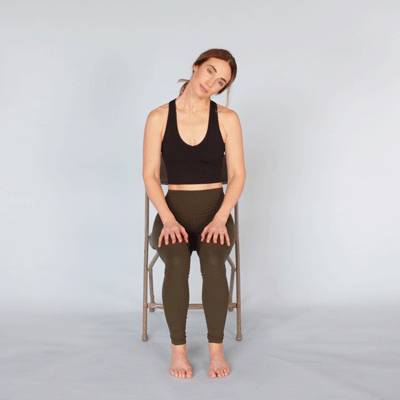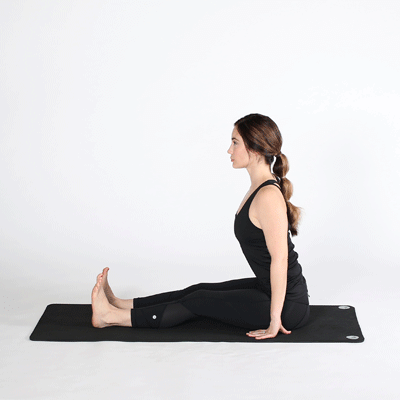Next time you experience a migraine episode, try these 5 stretches for relief: side neck bend, seated forward fold, child’s pose, thread the needle, and downward-facing dog.
If you regularly have migraine headaches, you might be looking for ways to ease them. Migraine, after all, can make it difficult to do daily activities.
Medication may help manage migraine attacks. However, if you’re looking for additional remedies, you can also try specific stretches.
These stretches can ease a migraine headache by releasing tension in your upper body. They’re also simple and gentle, making them ideal for an episode.
Side neck bend is a gentle stretch that releases tension in your neck and upper back.

How to do side neck bend
- Start in a seated or standing position, whichever feels most comfortable for you. Keep your spine neutral, relax your shoulders, and rest your arms alongside your body.
- Lower your right ear toward your right shoulder. Extend your left hand toward floor, then flex your fingers upward. Hold for 30 seconds.
- Return to your starting position. Repeat on the other side.
Resting your head on something can feel soothing. It’s a major element of the seated forward fold, also called the two-legged forward bend. The pose loosens the muscles in your legs.
You can do the forward fold in a chair, including a wheelchair. To do this stretch from a seated position, place a pillow on a table in front of you and fold your upper body toward the pillow.

How to do seated forward fold
- Sit on the floor and straighten your legs in front of you. Place a folded towel or blanket under your buttocks if you need support.
- Point your toes upward, as if the soles of your feet are against a wall. Lengthen your spine so you sit up tall.
- Bend forward from your hips, bringing your torso close to your thighs. Gently bend your knees if it feels more comfortable.
- Lie your forehead on your legs and place your hands on your feet. Hold for 30 seconds.
Child’s Pose is a classic yoga move. The stretch is restorative, especially if you let your arms relax alongside your body. It also stretches your upper back while calming your mind.
If you can’t sit down completely, modify this stretch by placing pillows between your feet and buttocks. This allows you to relax in Child’s Pose without fully flexing your spine.
How to do Child’s Pose
- Kneel on the floor. Spread your knees outward to the width of the mat. Keep your big toes touching and rest your buttocks on your heels.
- Lengthen your spine so you sit up tall and place your hands on thighs.
- Lower your torso between your thighs, reaching your hands toward the top of your mat.
- Place your forehead on mat and relax your neck, shoulders, and arms. Hold for 30 seconds. You may choose to rest your arms alongside your body, with your hands near your buttocks and palms facing upward.
If your shoulders feel tense, try this pose to stretch your upper back. It also involves a gentle low back twist, further releasing tension.
To modify this stretch for accessibility, add a pillow to the floor and lay your head on it. This lessens the intensity of twisting your back.
How to do Thread the Needle
- Start on all fours. Place your hands shoulder-width apart and your knees hip-width apart. Keep your spine neutral and rest the tops of your feet on the mat.
- Extend your right arm under left arm, reaching toward your left. Lower your right ear and shoulder to your mat, keeping yours knees and feet in place. Hold for 30 seconds.
- Return to all fours. Repeat on the other side.
Another classic stretch is the downward-facing dog. Forward-bending poses, such as this one, are thought to promote calm, reduce stress, and quiet your mind.
How to do Downward-Facing Dog
- Start on all fours. Place your hands shoulder-width apart and your knees hip-width apart. Keep your spine neutral.
- Press your hands into mat and tuck your toes under. Lift your hips to straighten your legs, but avoid locking your knees.
- Lengthen your spine, creating an upside-down “V” with your body. Reach your heels toward floor. Hold for 30 seconds.
When done regularly, stretching may help calm your body and mind.
Yoga is a form of exercise that combines stretching, breathing, and mindfulness. This may relieve stress and tension, which are common migraine triggers.
Solid research supports this effect. A 2020 randomized clinical trial found that yoga and medical therapy help manage migraine better than medical therapy alone.
Some physical activity may also help release endorphins, which the American Migraine Foundation calls your body’s “natural painkillers.”
When using stretching for migraine relief, try to focus on gentle movements. Intense, vigorous movements may worsen your symptoms.
In addition to stretching, you can also try these other natural remedies:
- acupressure
- aromatherapy with essential oils
- stress relief methods, such as deep breathing exercises
- supplements, such as magnesium
More tips for coping with migraine
- regular checkups with your doctor or another healthcare professional
- taking prescribed medications as directed
- limiting caffeine and alcohol intake
- avoiding known migraine triggers
- staying hydrated
- avoiding bright lights
- getting enough sleep
Stretches like seated forward fold, child’s pose, and downward-facing dog can loosen the muscles in your upper back. This may help relieve tension and stress, which are common migraine triggers.
Migraine management is a practice rather than a one-time treatment. Practice these stretches regularly, try to avoid your triggers, and take your migraine medication as directed.
If you’re new to stretching, speak with a healthcare professional first. They can provide recommendations to help you stay safe while stretching.




